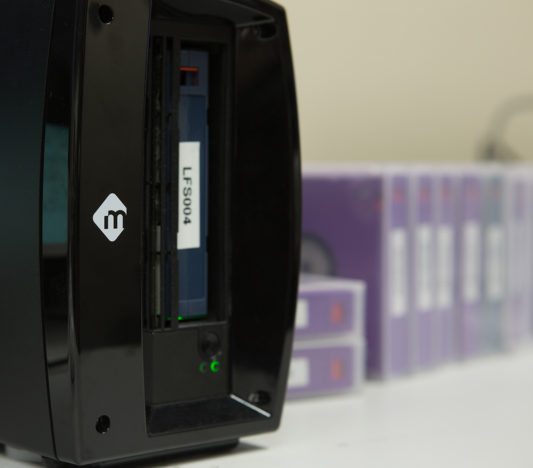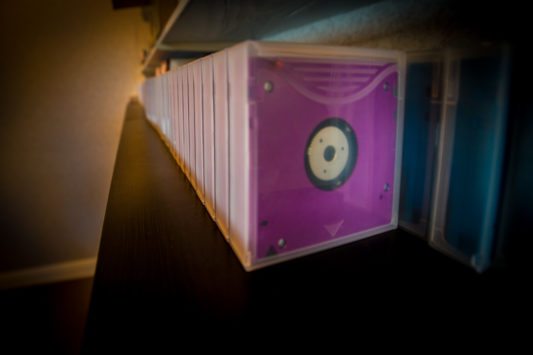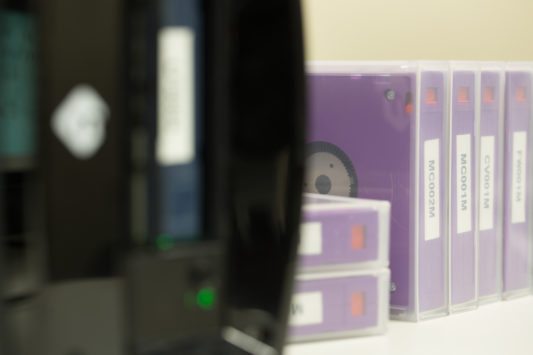Skystorm's Post Production Supervisor, Warren Williams, and Senior Editor, Jason Chamberlain, unpacking the SAN. …
Skystorm is Going Back to Tape….Again
A Better Solution to Video Storage
A long time ago in a galaxy far, far away….all video was done on tape. It was bulky, it was delicate, early cellulose film was also very flammable – but it was the standard. Until pretty recently, some variation of tape was used for filming, storage and archiving – albeit a much more stable form than the 16mm stored in tin cans of yesteryear. As an industry standard we have seen that physical hard drives are most commonly used, and lately we have also seen the adaptation of the cloud. Here at Skystorm we feel we have found the best mix of all worlds, which is why Skystorm has gone back to tape…again. LTO that is.
No, not this tape!

What is LTO?
When first introduced in 2000, LTO (Linear Tape-Open) drives were a breakthrough technology for massive data storage. With other seemingly more modern approaches to back up data, such as aforementioned cloud back-up and hard drive systems, LTO is still known for reliability and longevity even decades after it’s first release.
LTO is magnetic tape data storage technology, in which the standard form-factor goes by the name of Ultrium. Skystorm now uses Ultrium LTO’s latest and most advanced generation, LTO-7, which is able to hold 6.0TB of native data and 15TB of compressed data. LTO has come a long way as the new versions have been released, each LTO generation has increased in speed and space. The new LTO-7 is almost the speed of an SSD drive, compared to LTO-6 that runs at half that speed.
Even though it’s the latest version of its kind, LTO-7 is able to read LTO-7, 6 and 5. In addition, it is able to write two generations of tape – it’s own, and the previous LTO-6 generation.

The Switch to Tape – Better Known as Hard Drive Wrangling
Before using LTO to store data, Skystorm used a system of hard drives — multiple, redundant copies of hard drives that took up a lot of space and had to be meticulously cataloged.
“We were concerned about the shelf life and the fact that drives can easily become corrupted or dropped or damaged; we needed a longer term solution.”
–Warren Williams, Skystorm’s Post Production Supervisor.
LTO archive systems became our go-to option due to their technological advancement over the past few years with its speed and capacity having greatly increased. A decision that we were reassured of being the right move when we discovered during the transfer process, that one in thirty hard drives had age related failures. This is one of the reasons that we will continue to use a safety backup system. We simultaneous write the same project on two tape decks. One copy of the tape set is stored in our post production department for easy access, the other copy is sent to our other building for offsite storage and safe keeping.
A Step Away from the Cloud
Skystorm can now store an extensive amount of data on a tape relatively inexpensively and at a faster rate than cloud services — not to mention that tape storage can be accessed offline in contrast to accessing data from cloud storage that is dependent on internet availability.
We still use cloud based proofing for our clients, but as a storage solution it no longer makes sense for us. Especially as we continue into our second decade in the commercial video production industry, we process and store a large amount of video. Cloud storage is paid on a monthly or annual basis, where tape is only a one-time cost. One of our retainer clients alone requires an average of 30 terabytes per month – the cloud storage cost would be astronomical. In addition, transferring to the cloud is a slow process. What would take a week to send to the cloud could be stored on tape in a few hours.
Additional Advantages of Tape Storage
The tapes themselves are cost effective, even cheaper than hard drives, and continually decrease in price. Tape drives that are two generations behind are still compatible with its latest generation, providing longer usage of tape drives. All of these cost benefits factor in to become a huge benefit to our high volume retainer clients.
In addition to stability, the software that we use to store the media on tape, uses checksum verification during the writing process. This secures data during transfer by running an algorithm called cryptographic hash function on a data item, or in this case, on a tape drive. Checksum verifies the copy of the drive ensuring that the copy is genuine and error free during the writing process to ensure no surprise corruptions are found later.
The storage of tapes are convenient due to the tapes’ size and shape, making it a simple task to store—usually lined neatly along a shelf. This also means they are easily transported should the need arise.

As Warren mentioned earlier regarding his concern about shelf-life, another benefit that Skystorm is experiencing by using LTO tape drives is the longer shelf-life of roughly 20 to 30 years. This is another huge benefit to our long term clients. We have been around since 1998 – and even as we continue to grow, we still have clients that have been with us from the beginning. Serving these relationships by keeping our systems stable for the long term is very important to us.
Disadvantages of LTO: Few and Far Between
One of the disadvantages that come with using LTO tape drives for storage are keeping up of transferring data up the generational lines every few years in order for it to stay compatible with the most current generations of LTO drives.
Warren notes that the “data would still be in tact and available using older drives, but in order for newer drives to read the data, it would need to be re-archived using newer generations of drives and tape.”
Another disadvantage is that LTO has limited “drag and drop” functionality, as it utilizes a linear writing process. Writing files on the large LTO-7 tapes can be difficult as the drive must bypass all previous data to begin writing to open space.
While these are noteworthy disadvantages, they aren’t sizable enough to deter Skystorm from using LTO tape drive storage. Besides, as our Post Supervisor, Warren is rather picky (in the best ways!) If it’s good enough for him, that means it’s a great solution for our company.

Working Together: LTFS & LTO
LTFS, Linear Tape File System, is the universal standard file format that is written to the tapes. Once the data of a tape is written to the LTFS format, anyone with an LTO tape deck can read the data. This function enables direct, intuitive, and graphical access to data. As we have expanded to worldwide clients, we are not limited by format and software incompatibilities.
A Happy Solution
With the use of LTO and LTFS to store and manage media, we here at Skystorm feel secure and satisfied with our decision to go back to tape. To provide our clients with the highest quality of media access and to ensure our reliability as a company when it comes to your media storage, LTO tape drives are Skystorm’s happy solution to the lingering dilemma within production companies.
This update to how we handle our video in-house does not change the fact that we still use cloud based proofing for our clients and the good old hard drive when the need arises. Like we said – the best of all worlds.


